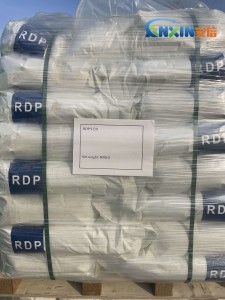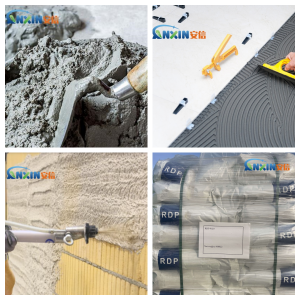Redispersible polymer powder (RDP) is a crucial organic polymer modification material in dry-mix mortars for construction. It is widely used in systems such as tile adhesives, insulation mortars, self-leveling mortars, and plaster mortars. Its primary function is to improve the mortar’s bond strength, flexibility, crack resistance, and workability, making it an indispensable additive for achieving high-performance building materials.
1. Core Performance Characteristics of RDP
1.1. Excellent Redispersibility
RDP is a polymer emulsion formed by spray drying into a powder. Upon contact with water, it redisperses into a stable emulsion system, resulting in a uniform distribution of polymer particles throughout the mortar. This property ensures that the organic polymer forms a continuous polymer film during the hardening process, enhancing the material’s internal flexibility and adhesion.
1.2. Enhanced Bond Strength
RDP significantly improves the bond between mortar and substrates, tiles, or insulation boards. The polymer network formed by the latex film after curing effectively disperses stress, reduces interfacial delamination, and ensures excellent adhesion of the mortar to a variety of substrates.
1.3. Improved Flexibility and Crack Resistance
By incorporating an elastic polymer into the mortar, RDP effectively absorbs deformation caused by stress fluctuations, improving the mortar’s crack resistance and impact resistance. It is particularly suitable for applications requiring high flexibility, such as exterior wall insulation systems and tile adhesives.
1.4. Improved Workability and Water Retention
RDP improves flowability and thixotropy in mortar, facilitating smoother construction. Its film-forming properties also reduce rapid evaporation, enhancing the mortar’s water retention and open time.
1.5. Excellent Weathering and Alkali Resistance
High-quality RDP maintains excellent stability under long-term outdoor exposure and is not susceptible to pulverization or degradation. Its excellent alkali resistance allows it to withstand the high pH environment of cementitious systems, ensuring long-term material performance stability.
2. Key Factors Affecting RDP Performance
2.1. Polymer Type
The main components of RDP include ethylene-vinyl acetate copolymer (EVA) and ethylene-vinyl acetate-acrylic acid copolymer (VAE/VA/VeoVa). Different systems determine the balance between flexibility, adhesion, and weather resistance. For example, EVA-based RDP offers excellent flexibility and is suitable for tile adhesives and thermal insulation mortars; whereas VeoVa-based RDP exhibits superior water and aging resistance, making it suitable for exterior decorative mortars and high-end plasters.
2.2. Glass Transition Temperature (Tg)
Tg determines the softness and strength of the RDP film. Low-Tg products (-10°C to 0°C) form flexible films suitable for applications requiring high ductility; high-Tg products (above +10°C) offer higher hardness and heat resistance.
2.3. Formulation System Compatibility
RDP exhibits synergistic effects with other additives, such as HPMC, starch ethers, and defoamers. Proper combination can optimize the workability and mechanical properties of the mortar; otherwise, it may affect dispersion or prolong curing time.
3. Key Points for RDP Selection and Application Recommendations
3.1. Selecting Performance Based on Application
Tile Adhesives and Plaster Mortars: Low-Tg, highly flexible EVA-based RDP is recommended to improve adhesion and crack resistance.
Exterior Insulation Systems (EIFS): Choose VAE or VeoVa-based RDPs that combine weather resistance and flexibility.
Self-leveling Mortars and Flooring Materials: Choose high-strength, high-hardness RDPs to ensure compressive and abrasion resistance.
3.2. Pay Attention to Product Solids and Ash Content
RDPs with high solids content (≥98%) and low ash content (≤10%) offer more stable quality, fewer impurities, and are less prone to clumping.
3.3. Investigating Brand Stability and Compatibility
RDP particle size, protective adhesive system, and additives vary significantly among manufacturers. The selection process should be based on test results to determine the best match for the specific mortar system.
As the most critical polymer-modified component in modern dry-mix mortar, RDP performance directly determines the material’s durability and construction experience. Scientifically understanding RDP’s performance mechanisms, understanding the differences in polymer types and Tg, and accurately selecting RDP based on application scenarios are key to improving the quality and competitiveness of building materials.
Post time: Oct-11-2025








